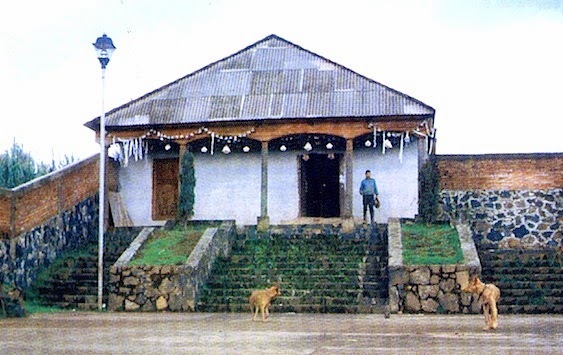Two contrasting wooden ceilings span the nave at Tanaquillo. A flat, beamed ceiling covers the western end, while a traditional, “inverted trough” style ceiling stands over the eastern part, ending in a fanlike avenerado.
This latter plank ceiling has been recently restored and largely repainted. According to an inscription, the murals date from the 1880s.
 |
| Tanaquillo, the avenerado at the east end |
Set against plain, light blue panels framed with ocher borders, portraits of ten of the Twelve Apostles appear in rows of rococo style medallions.
Boldly, even crudely painted in red, cream and sky blue, as at Corupo the saints are shown in a variety of attitudes—frontally and in profile—each accompanied by his principal attribute and name.
Boldly, even crudely painted in red, cream and sky blue, as at Corupo the saints are shown in a variety of attitudes—frontally and in profile—each accompanied by his principal attribute and name.
However, only two of the Apostles—heavily retouched—are apparently original: San Andrés and Santiago, in the rectangular panels closest to the east end. All the others are recent representations based on what is thought to be the original Apostolado sequence.
The only other images are those of the Archangels Michael and Raphael, squeezed awkwardly into the narrow, triangular corner frames at the east end.
St Michael, the patron saint of Tanaquillo, is the more interesting figure of the two, dressed as a Roman soldier subduing the fearsome Devil beneath his feet.
St Michael, the patron saint of Tanaquillo, is the more interesting figure of the two, dressed as a Roman soldier subduing the fearsome Devil beneath his feet.
text © 2014 Richard D. Perry. images by Carolyn Brown and Niccolò Brooker

















































